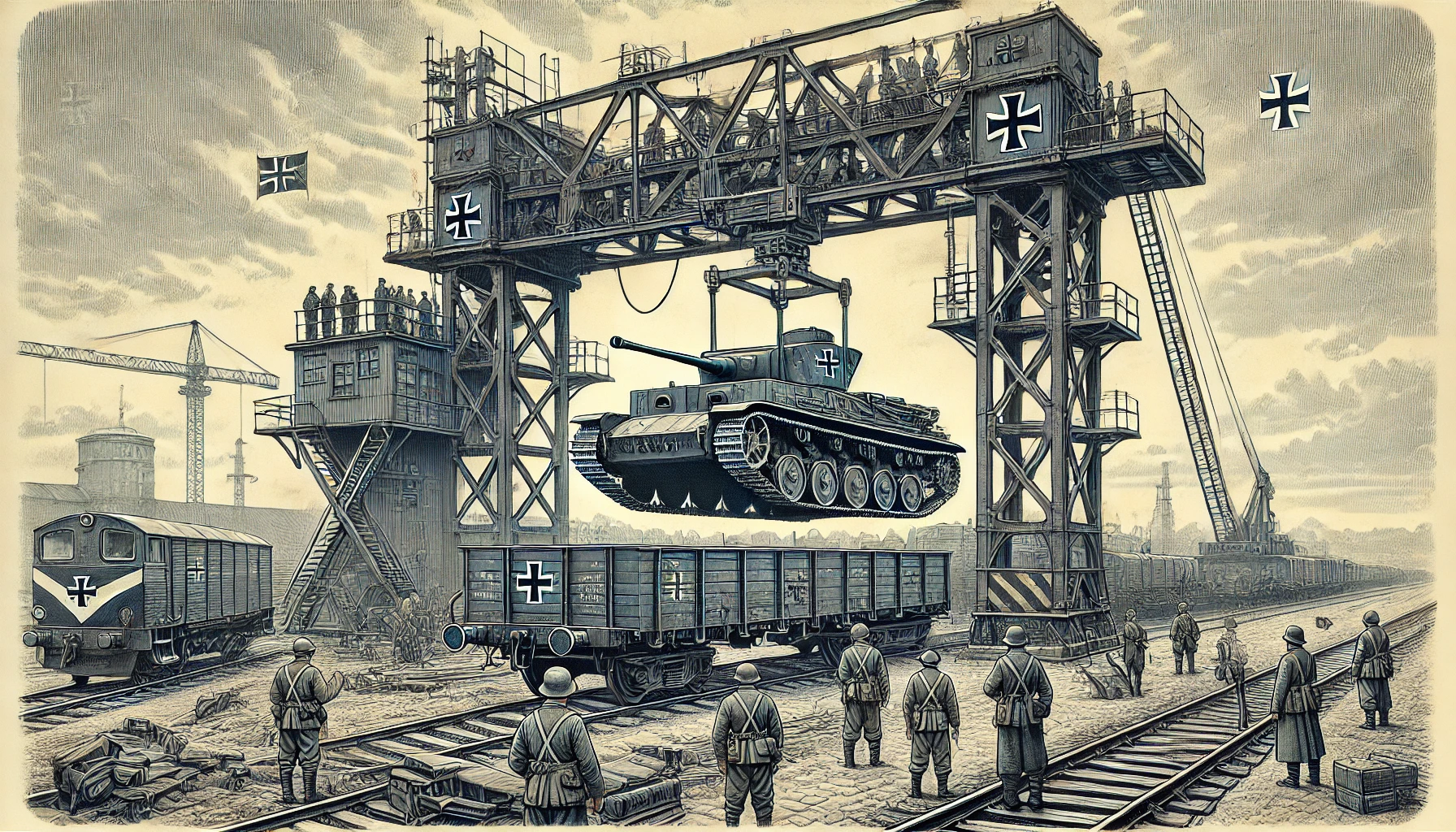The WW2 German Railway Gantry Crane is an engineering marvel that played a pivotal role in the success of Germany’s wartime logistics during World War II. These cranes were used to transport, load, and unload massive military equipment, supplies, and vehicles swiftly across railway systems. Understanding the historical significance, design, and impact of these gantry cranes provides a deeper insight into the innovative military logistics strategies employed during the war.
This article delves into the history and functionality of the WW2 German Railway Crane, highlighting its strategic importance during the war and its lasting impact on modern engineering practices.
The Necessity of Heavy Lifting in Wartime
During World War II, logistics were a crucial component of military strategy. For any army to succeed, it needed efficient systems to transport weapons, supplies, and equipment. The sheer scale of the war and the rapid advances on the battlefield required a robust and effective transport infrastructure.
Challenges of Transporting Heavy Military Equipment
The war necessitated the transportation of heavy machinery such as tanks, artillery, aircraft, and large ammunition loads. Traditional cranes or lifting methods were often inadequate for handling these massive objects. Moreover, moving them quickly was essential to keep up with the fast-paced demands of the battlefield. This is where the WW2 German Railway Gantry came into play.
Role of Railways in German Logistics
During the war, the German military heavily relied on railways to move troops, equipment, and supplies. Rail transport was efficient and relatively faster compared to other methods, such as road transport, which could be delayed by adverse weather conditions or enemy attacks. However, the success of rail-based logistics relied heavily on infrastructure that could support the rapid loading and unloading of massive cargo.
Design and Functionality of the WW2 German Railway Gantry Crane
The WW2 German Railway Gantry Crane was specifically designed to meet the increasing demands of wartime logistics. Its construction and capabilities allowed it to perform vital tasks that would otherwise have slowed down military operations.
The Structure and Power Systems
The gantry crane consisted of a robust structure mounted on a set of railway tracks, allowing it to move along rail sidings or railway yards. Its frame was built to support very heavy loads, often in excess of 50 tons, which was necessary for lifting large military vehicles such as tanks, artillery, and aircraft.
The cranes were powered by steam engines or internal combustion engines, which allowed them to operate in areas where access to electricity or other power sources was limited. This independence from centralized power made them incredibly valuable for remote or forward-deployed areas.
Loading and Unloading Capabilities
One of the key features of the WW2 German Railway Crane was its ability to move large, heavy objects from one place to another with remarkable speed. The crane’s elevated design provided sufficient clearance to lift and move large equipment onto railway cars, facilitating the transportation of military machinery.
The cranes were often use in conjunction with flatbed railcars, which could carry a range of oversize loads. By placing these cranes on strategic points along rail lines or near military depots, the German military ensured that heavy equipment could be moved and distributed efficiently across the warfront.
The Role of the WW2 German Railway Crane in Wartime Logistics
The WW2 German Railway Crane became an indispensable tool for the military. It enabled swift and efficient transport of critical supplies and equipment across long distances, allowing the German war machine to operate smoothly in challenging conditions.
Rapid Deployment of Military Vehicles
One of the primary roles of these cranes was moving military vehicles, including tanks, artillery, and trucks, from one location to another. The WW2 German Railway Gantry Crane made it possible to load and unload these heavy objects with minimal downtime. This quick handling ensured that military vehicles could be deploy to the front lines without delay.
Case Study: Transporting Panzer Tanks
German Panzer tanks, which were pivotal to the success of the Blitzkrieg strategy, had to be move rapidly across Europe. The WW2 German Railway Crane was essential in loading these heavy tanks onto flatbed railcars, where they could be transported across rail networks to their intended destinations.
Support for Air Force Logistics
In addition to heavy vehicles, aircraft also required specialized handling during transport. The WW2 German Railway Gantry Crane was use to move large aircraft between factories, airfields, and rail stations, where they were load onto trains. This ensured the rapid deployment of fighters and bombers to various operational theaters.
Aircraft Transport Example: Junkers Ju 87 Stuka
The Junkers Ju 87, or Stuka dive bomber, was one of the most iconic aircraft use by the German Luftwaffe. The gantry crane was use to move these large aircraft across the railway network, facilitating their rapid relocation for air raids and other operations.
Optimizing Supply Chain Efficiency
The crane was also use for unloading essential supplies such as ammunition, fuel, food, and medical equipment. These items were crucial for maintaining military operations on the front lines. By enabling rapid unloading of freight trains, the WW2 Railway Gantry Crane ensured that resources reached their destinations without unnecessary delays.
Strategic Importance and Legacy of the WW2 German Railway Gantry Crane
While the WW2 Railway Gantry Crane was a significant part of the German wartime logistics network, its impact extended far beyond the war itself. Its design principles influenced modern heavy-lifting equipment and contributed to advancements in logistics technologies.
Speed and Efficiency in Military Logistics
The introduction of these cranes revolutionize the way that military equipment was transport. By allowing for the quick loading and unloading of supplies and vehicles, the WW2 German Railway Gantry Crane minimized downtime at rail depots and ensured that military operations continued without interruption. This enhanced speed and efficiency directly impacted the outcome of key battles.
Versatility Across Different Environments
One of the main strengths of the WW2 Railway Gantry Crane was its ability to operate in a variety of settings. Whether in urban depots, military bases, or temporary rail yards in conflict zones, the cranes proved to be adaptable to the unique challenges of each environment. This flexibility made them invaluable for the German military’s strategic operations.
Modern-Day Influence of the WW2 Railway Gantry Crane
Although the WW2 German Railway Gantry Crane was design for wartime use, the principles of its design and functionality have left a lasting mark on the field of heavy lifting and logistics.
Evolution of Gantry Cranes in Civilian Applications
In the decades following World War II, the design of gantry cranes evolved, incorporating new materials, technologies, and automation features. Modern gantry cranes are now use in ports, construction sites, and manufacturing facilities worldwide. Many of the concepts develope during the war, such as the integration of cranes into railway systems for efficient cargo handling, continue to be use in these sectors.
Advancements in Crane Technology
Today, cranes benefit from advancements in hydraulic systems, automation, and computer-aided design. These modern cranes can handle heavier loads with greater precision and efficiency than their WWII predecessors. However, the WW2 Railway Gantry Crane set the stage for many of these innovations, highlighting the importance of heavy lifting in logistics and transportation.
Conclusion
The WW2 German Railway Gantry Crane was critical to the German military’s logistics network during World War II. Its ability to handle heavy equipment and supplies efficiently and rapidly had a profound impact on the war effort. These cranes allowed for the swift deployment of military vehicles and aircraft, streamlined supply chains, and ensured that the German forces remained well-equipped on the front lines.
The legacy of the WW2 Railway Gantry Crane extends beyond its wartime use, as its design and functionality influenced modern heavy-lifting technologies. Today, gantry cranes continue to play an essential role in industries around the world, providing a lasting reminder of the strategic importance of logistics in both wartime and peacetime.
Through this article, we can appreciate the innovative engineering and logistical thinking that shaped not only the outcome of World War II but also the future of industrial transportation and heavy lifting.
Zet Up Mat Classroom Creating an Engaging Math Learning Environment



